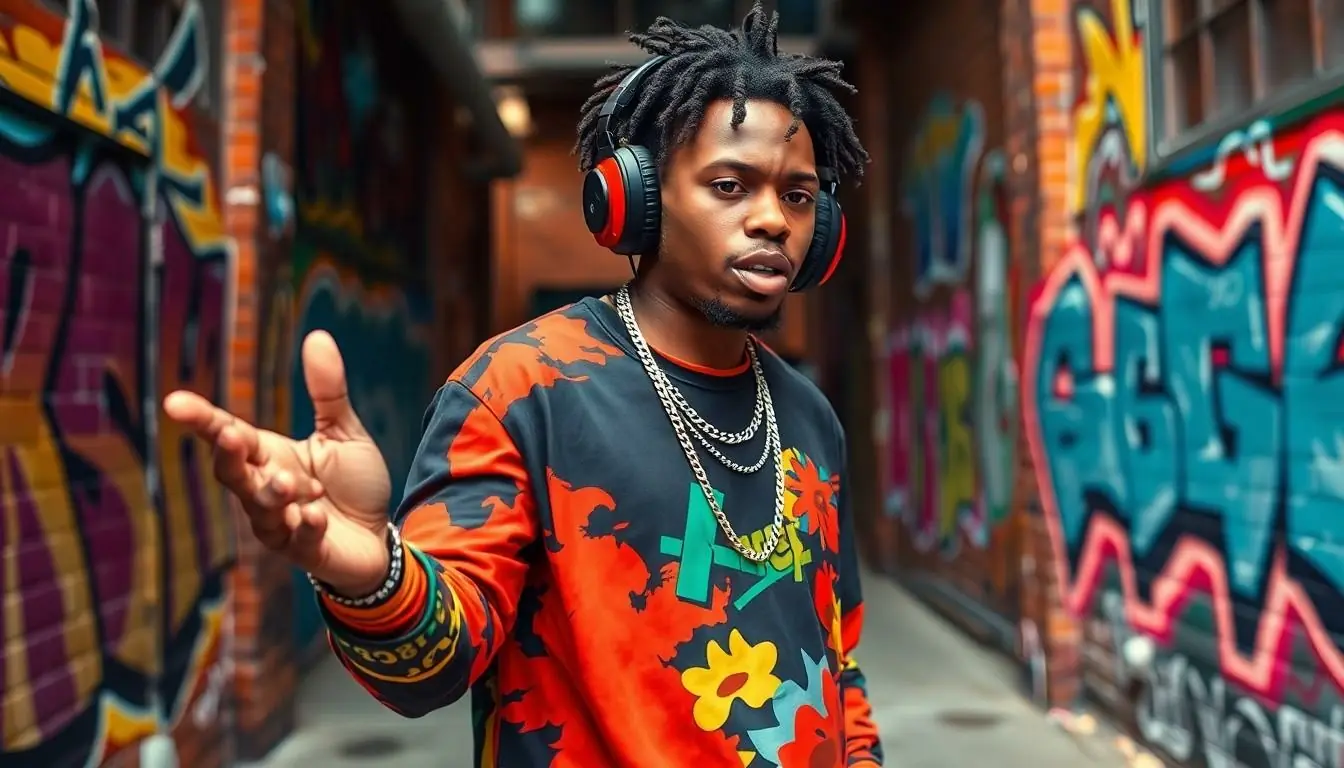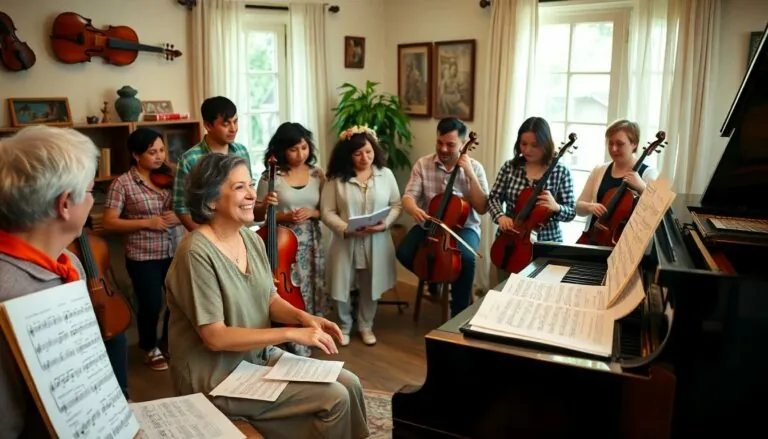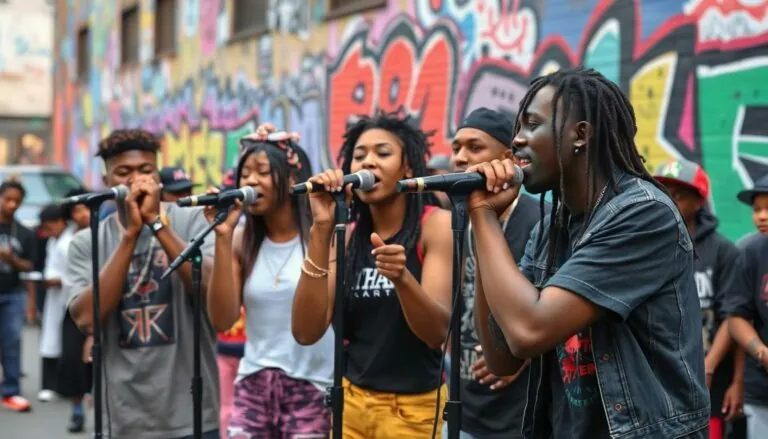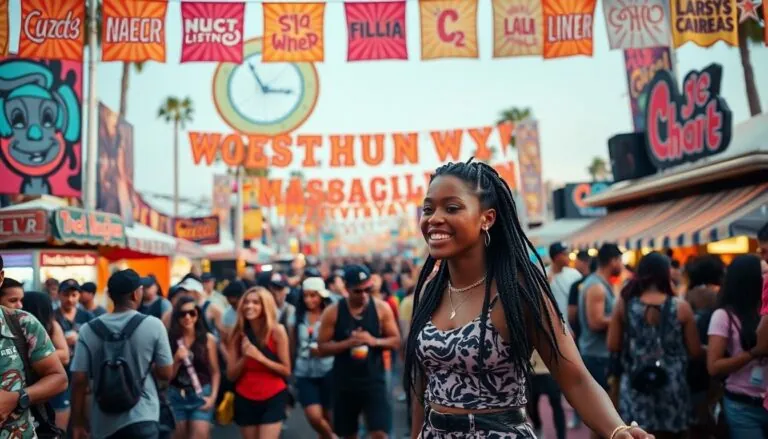Table of Contents
ToggleIn the world of music, experimental hip hop stands out like a unicorn at a dog show. It’s a genre that defies conventions and invites listeners to explore uncharted sonic territories. Imagine a place where beats collide with unexpected sounds, and lyrics challenge the very fabric of reality. This isn’t just music; it’s an adventure for the ears and mind.
Overview of Experimental Hip Hop
Experimental hip hop challenges conventional norms, pushing the boundaries of sound and lyricism. This genre blends diverse elements, including electronic, jazz, and funk music, creating an innovative soundscape. Unique production techniques often characterize it, with artists utilizing unconventional instruments and sampling methods.
Many artists in this genre are known for their willingness to take risks. They often incorporate non-traditional song structures, allowing for greater creative expression. Notable figures, such as Flying Lotus and Death Grips, exemplify this approach through their avant-garde styles and unexpected collaborations.
Lyricism within experimental hip hop frequently explores abstract themes and complex narratives. Artists tackle subjects such as identity, technology, and societal issues. These thought-provoking lyrics contribute to the genre’s depth and invite listeners to engage with the music on multiple levels.
The influence of experimental hip hop extends beyond music itself. Visual art, fashion, and performance art often intersect with this genre, creating a comprehensive cultural movement. Many artists utilize multimedia installations to enhance their musical presentations, resulting in an immersive experience for audiences.
Collaborations play a significant role in the evolution of experimental hip hop. Artists frequently cross genres, merging influences from rock, pop, and electronic music. This collaborative spirit fosters innovation, leading to the emergence of new sounds and styles within the genre.
Overall, experimental hip hop continues to evolve, attracting a diverse audience. It invites listeners to explore uncharted territories in music, encouraging an appreciation for the unconventional. This genre champions creativity and individuality, making it a vital part of contemporary music culture.
Origins and Influences
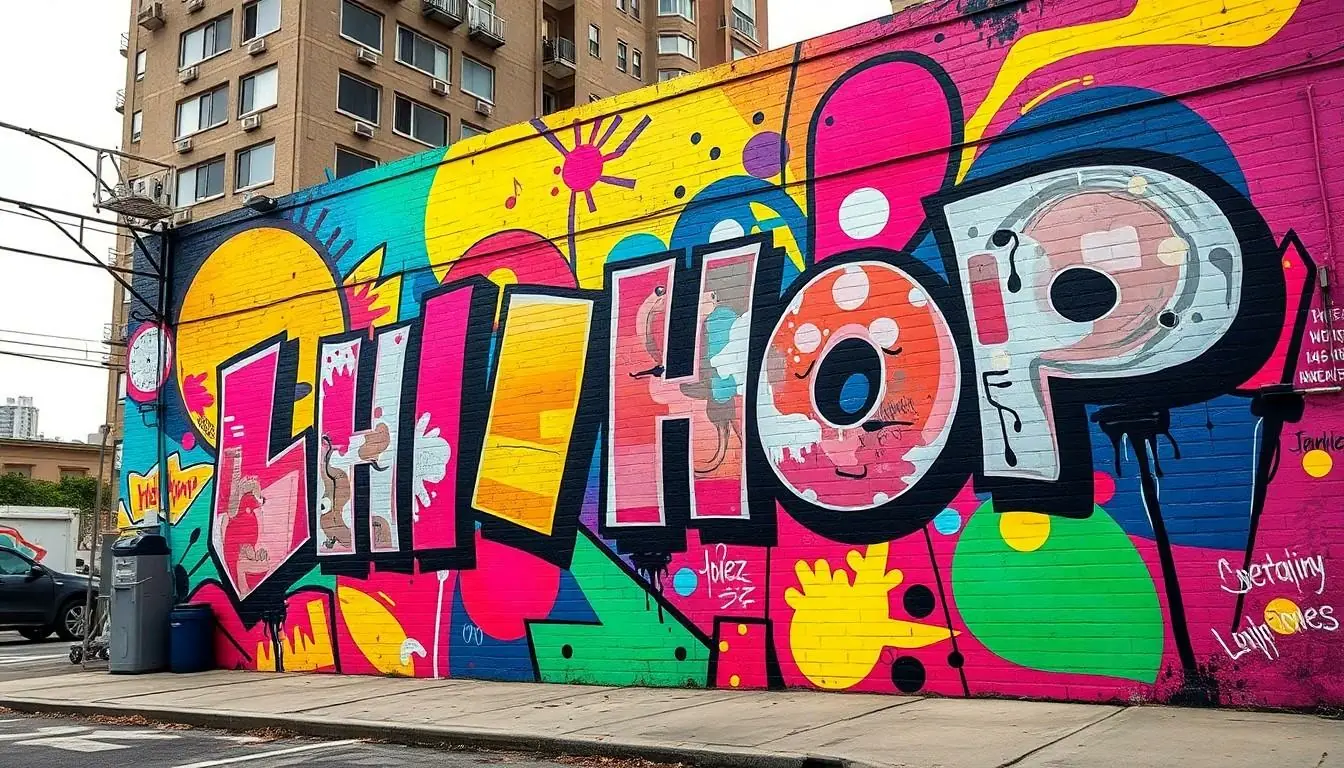
Experimental hip hop emerged as a response to traditional music genres, reflecting innovation and diversity through its unique sound. This genre draws from various influences, creating a rich cultural tapestry.
Key Artists and Innovators
Flying Lotus stands out as a prominent figure in experimental hip hop, pushing the boundaries with his eclectic soundscapes. Death Grips exemplifies risk-taking innovation, melding aggressive beats with avant-garde lyricism. Shabazz Palaces significantly contributes a blend of abstract poetry and electronic sounds, enriching the genre’s diversity. Artists like Aesop Rock and Kid Cudi further expand the landscape, integrating personal narratives and wide-ranging influences. Each artist plays a critical role in shaping the genre, demonstrating varying creative techniques and collaborating across disciplines.
Music Genres that Shaped Experimental Hip Hop
Jazz influences create intricate rhythms and improvisational elements in experimental hip hop. Funk provides a foundation for groove-oriented sounds, offering a backdrop for innovative lyricism. Electronic music introduces digital manipulation, allowing for creative sampling and sound design. Various other genres such as punk and rock also contribute with their rebellious spirit and distinctive styles. This fusion of genres facilitates a diverse sonic palette, encouraging artists to explore and redefine boundaries within hip hop, ultimately expanding the genre’s reach and impact.
Sound and Production Techniques
Experimental hip hop features innovative soundscapes that define its unique character. The genre thrives on diverse techniques that allow for creativity and expression.
Use of Sampling and Looping
Sampling and looping serve as foundational techniques in experimental hip hop. Artists combine distinct audio snippets from various sources, transforming them into new creations. Looping enhances this process, creating rhythmic patterns that resonate with listeners. Key figures like Flying Lotus use samples from jazz, funk, and electronic music, meticulously crafting layers that breathe life into their tracks. These methods not only add depth but also invite reinterpretation of existing sounds. Through these practices, artists push auditory boundaries, allowing fresh narratives to emerge.
Incorporation of Electronic Elements
Electronic elements play a crucial role in shaping the sound of experimental hip hop. Artists frequently integrate synthesizers, drum machines, and effects to manipulate sounds in novel ways. This approach allows for the creation of textures that defy traditional hip hop norms. Death Grips exemplifies this practice, utilizing aggressive electronic beats to heighten intensity. The blend of digital and acoustic sounds enables a wide range of sonic experimentation. Further, artists harness technology to explore new possibilities, ensuring their music remains innovative and engaging. This incorporation of electronics reinforces the genre’s relentless drive for originality.
Lyrical Themes and Messages
Experimental hip hop showcases a wealth of lyrical themes that challenge listeners and provoke thought. Artists often blend abstract concepts with poignant narratives, creating unique experiences.
Abstract and Conceptual Lyrics
Abstract and conceptual lyrics define much of experimental hip hop. Artists employ intricate wordplay and imaginative storytelling, inviting listeners into diverse interpretations. Aesop Rock exemplifies this with dense vocabulary and surreal imagery, pushing the envelope of traditional lyricism. Shabazz Palaces embraces cryptic verses that explore identity and existence. These artists elevate the genre through unconventional approaches, transforming personal reflection into expansive tales. The complexity in their storytelling mirrors the genre’s adventurous spirit, enhancing the overall listening experience.
Social and Political Commentary
Social and political commentary thrives within experimental hip hop. Artists address pressing issues such as systemic inequality, technology’s impact, and the struggles of marginalized communities. Death Grips frequently tackles dystopian elements, critiquing modern society and consumer culture. Kid Cudi addresses mental health, providing a voice to those facing similar challenges. Each artist contributes a unique perspective, fostering discussions around significant themes. These narratives resonate with listeners, establishing a platform for awareness and change in society.
Notable Albums and Projects
Experimental hip hop features groundbreaking albums and projects that redefine the genre. Landmark releases significantly influence sound and culture, while emerging artists continue to push boundaries.
Landmark Releases
Flying Lotus’s Cosmogramma stands out with its fusion of jazz and electronic elements. This album showcases innovative production techniques and complex arrangements, offering a unique listening experience. Death Grips released The Money Store, a project that revolutionized the genre with its aggressive beats and captivating lyricism. Shabazz Palaces’ Black Up provides a blend of abstract soundscapes and intricate storytelling, showcasing the genre’s depth. Aesop Rock’s Labor Days features complex wordplay and rich narratives, earning acclaim for its thought-provoking lyrics.
Emerging Artists to Watch
In the realm of experimental hip hop, several talented artists are making a mark. Tierra Whack combines diverse genres with whimsical storytelling, captivating audiences with her creativity. Lil Uzi Vert stands out with genre-blurring sounds and playful lyricism that challenge traditional norms. Earl Sweatshirt explores introspective themes through intricate verses, adding a distinct flavor to the genre. Yves Tumor pushes sonic boundaries with a mix of avant-garde influences, attracting attention for its innovation. These artists reflect the genre’s evolving nature, promising exciting developments in the future.
Experimental hip hop stands as a testament to the genre’s boundless creativity and innovation. By merging various musical influences and pushing lyrical boundaries, it offers listeners a rich tapestry of sound and meaning. The genre’s commitment to exploring complex themes fosters a deeper connection with audiences, encouraging them to engage with the music on multiple levels.
As artists continue to experiment and collaborate, the landscape of experimental hip hop will undoubtedly evolve. With each new release, the genre promises to challenge perceptions and redefine what hip hop can be. This ever-changing movement not only enriches the music scene but also inspires a broader cultural dialogue, ensuring its place in the future of contemporary music.


